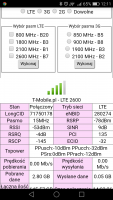Hello,
Some time ago I changed the LTE mobile internet operator due to better coverage, transfer and lower network load during peak hours. Internet when it comes to downloading and uploading works quite well and almost enough for my needs.
I have a Huawei b525 router and a Sorensen 1800MHz external antenna, and here is the problem. On the previous operator, the 1800MHz band was fine, but my current transmitter (200-300m in a straight line) sends internet in the 2600MHz band. Reading the parameters of my range, everything seems fine except for the SINR indicator which is low and jumps from 4 to 10 dB. In addition, RSRQ still jumps from -4 to -9dB. My problem is not the speed of the internet but its quality, sometimes I can lose packets in some games (not bad ping) and here the question is: will buying a new antenna receiving the 2600MHz band improve anything in the quality of the internet? Is the antenna really responsible only for the range, which is really nice and it will not help me with these unfortunate lost packages?
In the attachment I put all the Internet parameters, I hope that someone will be able to answer my question
Some time ago I changed the LTE mobile internet operator due to better coverage, transfer and lower network load during peak hours. Internet when it comes to downloading and uploading works quite well and almost enough for my needs.
I have a Huawei b525 router and a Sorensen 1800MHz external antenna, and here is the problem. On the previous operator, the 1800MHz band was fine, but my current transmitter (200-300m in a straight line) sends internet in the 2600MHz band. Reading the parameters of my range, everything seems fine except for the SINR indicator which is low and jumps from 4 to 10 dB. In addition, RSRQ still jumps from -4 to -9dB. My problem is not the speed of the internet but its quality, sometimes I can lose packets in some games (not bad ping) and here the question is: will buying a new antenna receiving the 2600MHz band improve anything in the quality of the internet? Is the antenna really responsible only for the range, which is really nice and it will not help me with these unfortunate lost packages?
In the attachment I put all the Internet parameters, I hope that someone will be able to answer my question




